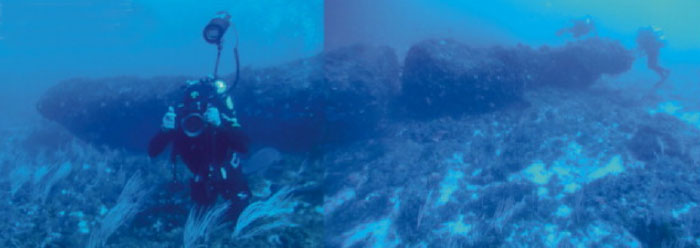Of all the scientific disciplines, underwater archaeology may be one of the most fascinating. These researchers examine artifacts our ancestors left behind before global sea level rose and covered them. A newly discovered monolith—a gigantic rock placed in what is today the Mediterranean Sea—confronts a few evolution-based errors about human origins.
Divers visited the monolith in 2014, capturing high resolution sonar images and underwater photographs. It lies on the undersea Adventure Plateau, found south of Sicily and north of Tunisia, Africa. Archaeologists from Italy and Israel described the results in the Journal of Archaeological Science: Reports.1
Today, the artifact lies about 140 feet below sea level, so it appears it was constructed back when sea level was at least 150 feet lower than today's level. Glacial meltwater near the end of the Ice Age caused a series of local "megafloods" around the globe, like the ancient Missoula Flood in America's Northwest. These explain the addition of vast amounts of water to the world's oceans.2
What clues indicate that men, not natural processes, moved this estimated 15-ton monolith into place? It has a somewhat regular shape, unlike most natural rocks. It also has three large bore holes, each of the same diameter. No known natural process drills big holes like these. People must have done the exacting work, but nobody yet knows why. Also, the nearest outcrop of this rock type is found about 1,000 feet to the south, indicating people moved the massive monolith.
The study authors wrote, "The monolith found, made of a single, large block, required a cutting, extraction, transportation and installation, which undoubtedly reveals important technical skills and great engineering."1
What were the Ice Age dwellers like who engineered this big rock into place? Primitive, freshly-emerged-from-apes sub-humans known only from ape-to-man illustrations would not have carved, drilled, transported, and erected such tremendous stone monuments—but Noah's descendants sure could have.
The study authors pinpointed a couple of concepts about ancient man that need revision. First, evolutionists have long asserted that, for thousands of years, early man lacked the technology to cross waterways. But the position of this site on Adventure Plateau appears well suited to have been a pivotal point of travel across land and open water, perhaps from Europe to Africa. In any case, if these ancient humans could move a 15-ton rock, they could build a boat. The researchers wrote, "The recent findings of submerged archaeology have definitively removed the idea of 'technological primitivism' often attributed to hunter-gatherers coastal settlers."1
Second, according to the researchers, "The discovery of the submerged site in the Sicilian Channel may significantly expand our knowledge of the earliest civilizations in the Mediterranean basin and our views on technological innovation and development achieved by the Mesolithic inhabitants." In other words, evolutionary views of ancient man with stunted skills need to "expand" to include their ability to produce stunning "technological innovation."1
Fully formed, fully intelligent people explain these and other monoliths that comprise mankind's earliest artifacts.3 Ancient monument-building geniuses don't fit the evolutionary scheme, but they directly follow from Adam as our ancestor.
References
- Lodolo, E., and Z. Ben-Abraham. 2015. A submerged monolith in the Sicilian Channel (central Mediterranean Sea): Evidence for Mesolithic human activity. Journal of Archaeological Science: Reports. 3 (September): 398-407.
- See references in Thomas, B. Making Sense of Britain's Atlantis. Creation Science Update. Posted on icr.org July 27, 2012, accessed August 4, 2015.
- Thomas, B. Oldest Temple Topples Evolutionists' History of Religion. Creation Science Update. Posted on icr.org January 12, 2012, accessed August 4, 2015.
Image credit: Copyright © 2015 Elsevier B.V. or its licensors or contributors. Adapted for use in accordance with federal copyright (fair use doctrine) law. Usage by ICR does not imply endorsement of copyright holders.
*Mr. Thomas is Science Writer at the Institute for Creation Research.
Article posted on August 17, 2015.






















